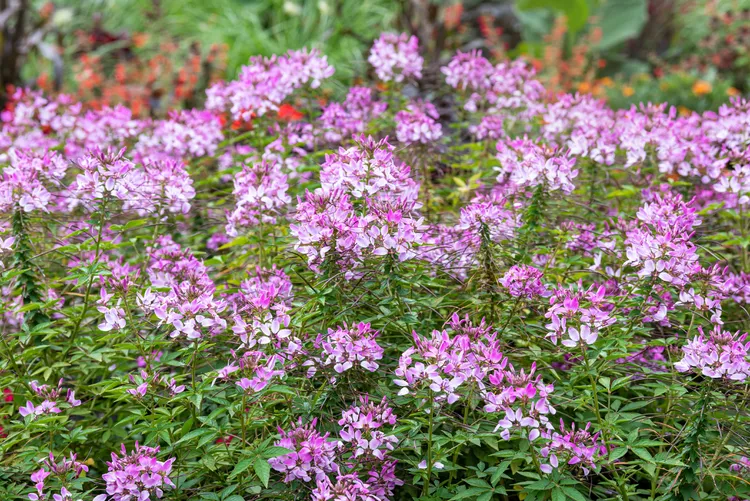| Common Name | Cleome, spider flower |
| Botanical Name | Cleome spp. |
| Family | Cleomaceae |
| Plant Type | Annual |
| Mature Size | 1.5-5 ft. tall, 1-2 ft. wide |
| Sun Exposure | Full, partial |
| Soil Type | Well-drained |
| Soil pH | Acidic, neutral |
| Bloom Time | Summer |
| Flower Color | White, pink |
| Hardiness Zones | 10-11 (USDA) |
| Native Area | South America |
Cleome Care
Averaging three to four feet in height, cleomes provide a welcome tall focal point in the annual garden, where compact bedding plants tend to rule. The pink, purple, white, and lavender flowers do not emit a noticeable fragrance, yet hummingbirds, butterflies, and hummingbird moths are drawn to these flowers all summer long.
Cleome is easy to start from seed and grows quickly. Once started, the plant seems to take care of itself. What’s more, the upright plant needs no staking if it is growing in full sun. Another boon: This plant shrugs off pests and diseases.

Light
Cleome flowers grow best in full sun. In shady conditions, the plants grow too tall and topple over and the bloom is diminished.
Soil
Cleome does best in average garden soil or rich, well-drained garden loam.
Water
Once established, cleomes are drought-tolerant, making them a welcome addition to the xeriscape garden. Add a three-inch layer of organic mulch to their planting bed, and you will decrease their water needs even further.
Temperature and Humidity
The ideal temperature range for cleome is between 75 and 80°F during the day and 60 to 65°F at night. The plant does not tolerate frost.
Fertilizer
If using good, well-drained soil and mulch, no fertilizer is necessary.
Types of Cleome
There are more than 100 species and multiple cultivars of cleome. These cultivars of the most widely grown cleome, C. hassleriana, are popular among gardeners for their color and growth habit:
- ‘Helen Campbell’ is a variety that offers pure white flowers and needs very little care.
- ‘Linde Armstrong’ is a compact 12- to 18-inch, sterile, and thornless variety with pink, rose, or mauve blooms.
- ‘Rose Queen’ is fragrant and eye-catching. This cultivar comes in shades of purple, white, cherry, and rose. Be mindful of the spines growing at the base of each leaf.
- ‘Sparkler Blush’ is a unique hybrid plant that has a bushy look with white or pink flowers.
- Spirit™ series are 2- to 4-foot tall plants with a better branching growth habit, but they have thorns and sticky foliage. Blooms are white, pink, or lavender.
Pruning
Cleome needs very light pruning. Snip off dead leaves or damaged areas during the growing season. If the plants are spindly right before planting, trim them back by half to encourage new growth once they are in the ground.
How to Grow Cleome From Seed
Cleome plants are propagated from seed. They are easy to start directly in the garden from seed, perhaps too easy because the plants self-seed to the point of being a nuisance.
The seeds need light to germinate, so you can just sprinkle them in the garden after the danger of frost is past and the soil has a temperature between 70 and 75°F. Look for seedlings after ten days. Alternatively, sow the seeds in the autumn, and they will germinate when the weather warms up in the spring.
If you allow the plants to self-seed, thin the newly emerging seedlings to allow at least 18 inches between plants.
Potting and Repotting Cleome
You can grow cleome in large containers, but choose a compact variety like the Sparkler™ series for best results. Combine your potted cleome with a mounding flower like vincas and a trailing flower like petunias for a full and lush container.
How to Get Cleome to Bloom
If you start with transplants, blossoms will appear from early summer until the first frost. Gardeners who grow cleome from seed usually see the first flowers in mid- to late June, depending on the climate. A location in full sun is required to get cleome to bloom.
Thinning out the seedlings not only improves the vigor of the individual plants but also encourages the most blossoms.
Common Problems With Cleome
Cleome is surprisingly resistant to pests and quite resilient against common plant diseases. Mildew and rust might become a problem if the plants are too crowded; thin the plants to avoid this problem. If the soil is not healthy, the plants will not be as healthy as they could be, and that will attract insects that could shorten the life of the plant.
-
-
Is Cleome an annual or perennial? Cleome is an annual plant, however, it readily reseeds so you might find seedlings popping up next spring in the same spot.
-
-
-
Does cleome like the sun or shade? Cleome needs full sun to thrive. It does poorly in the shade.
-
-
-
Where is the best place to plant cleome? The best place to plant cleome is in the back of a mixed flower bed or perennial bed where it creates a focal point and does not obstruct the view of shorter plants. Mass plantings or drifts of cleome are especially attractive. Cleome also makes a good container plant.
-
-
-
Do you deadhead cleome? Yes, cleome responds well to pruning. Deadheading spent flowers encourages new growth while preventing it from self-seeding.
-
